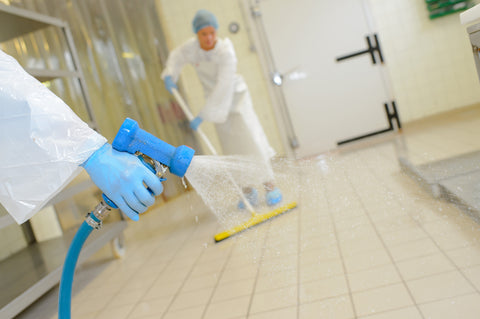
How things have changed. Twenty-five years ago, food allergens weren’t an issue. Today, every food processor needs to be conscious of allergens.
Allergens are highlighted throughout the FDA’s recently-issued Preventive Controls Regulations. Good Manufacturing Practices have been modified to include both cross-contamination and cross-contact. While these terms are sometimes used interchangeably, there’s a difference. A good explanation can be found at MenuTrinfo:
Cross Contamination
Cross-contamination [typically] … happens when foods are raw. Whether this is at the processing plant, when it’s in the field, or on the cutting board, cross-contamination happens when bacteria from one food product transfers to another.
More importantly, contamination implies that that one can easily avoid the problem altogether by heating it to a certain temperature. After all, that’s how you kill bacteria.
When people with allergies … express a concern about cross-contamination, the cooks or chefs’ first thought is that it will be fine if they just cook it off. The problem … of course, is that you can’t cook away an allergy, no matter how high the heat.
Cross-Contact
While cross-contamination refers to the transference of bacteria, cross-contact is the transference of proteins. Sadly, you can’t cook off a protein.
Proteins can transfer in many ways. This can be with a fork that stirs a pot of boiling noodles, or using an uncleaned grill. As allergies don’t burn off, even a food from a long time ago can cause cross-contact and a severe allergic reaction!
For the purposes of a food processor, allergen cross-contact means any unintentional incorporation of a food allergen into your products. The regulation mandates that food processors manage allergens. In practice, here’s what you do and don’t have to ensure:
- You DO have to make preventative protocols that minimize the potential for cross-contact.
- You DO have to establish sanitation controls, ensuring that food contact surfaces on which allergens are processed and handled are sanitary.
- You DO have to verify cleanliness; demonstrating that the food contact surfaces and equipment in question have been cleaned as documented.
- You DON’T have to validate your allergen cleaning and sanitizing program, but in reality, many processors conduct this exercise.
One of the reasons why allergens are emphasized in the regulation is apparent from Figure 1 developed by FARRP in 2016. Clearly, there has been an upward trend in allergen recalls for the past two decades. You can also see the same trend by looking at the FDA website.

So far, so good. You understand the regulation. You want to protect your company, your products and your customers. But how should you go about doing this?
Let’s look at how you might develop, document, implement, and maintain an Allergen Cleaning Program. A critical component of building this program will be making sure that all of the people doing the cleaning and management will be trained, and that the training is documented.
Many processors utilize visually clean as their “cleanliness yardstick.” Does it look clean? This sounds good. However, depending upon how the equipment is designed, visually clean is not always “properly cleaned.” Rather, the proper cleaning for equipment will depend upon the type of product being manufactured.
- Equipment in plants manufacturing dry products like bakery products and tree nuts are dry-cleaned, which means no water is used.
- Equipment in plants manufacturing most other foods, including ready-to-eat meats, entrees, and seafoods, are wet-cleaned using standard cleaning practices. This includes; rinse to remove gross soil; clean with detergent; rinse; sanitize; and rinse to remove the sanitizer.
Cleaning protocols must be developed by the food processor, usually with input from their chemical supplier. The chemical supplier needs to look at the operation and recommend the chemicals that will do the best job. Suppliers are also often called in to train the plant workers on handling and use of the chemicals and equipment needed for cleaning. Part of this training process must include the proper use of personal protective equipment (PPE) which includes gloves. The company’s staff needs to learn how to use the PPE, as well as how to maintain their protective equipment.
But, let’s get back to developing the cleaning protocols. When developing the allergen cleaning program, you need to make sure that your protocol is effective. In the words of the regulation, the processor must “determine whether or not the plan is sufficient to ensure clean equipment and environment using visibly clean criteria and quantifiable methods.”
So how do you determine that clean is clean enough? And what are “quantifiable methods?”
The best method is using allergen ELISA (Enzyme Linked Immuno-Absorbent Assay) tests. Validation tests should be done with the product that has the highest protein load. It’s also important to conduct a positive control.
There are different ways to validate a system: swabbing, product push through, finished product testing and evaluation of CIP rinse water. If you use ELISA tests, you should evaluate different tests and select the best one. If the target allergen is recovered during validation testing, the cleaning protocol should be enhanced. A minimum of two cleaning trials must be conducted to properly validate the protocol. In industry, many operations run more during validation trials. Once a cleaning regimen is established, it must be repeated each day. This process should be documented.
You will need a second party to verify that cleaning is done properly. This party will certify that procedures were followed and that equipment appeared clean. As part of cleaning verification, companies use swabs. These can be ATP, allergen swabs, protein swabs or even microbiological tests.
In the end, controlling allergens is a careful and costly process. But as a processor, it’s simply part of protecting consumers and your business.
REFERENCES
United States Food & Drug Administration, (2015), Title 21, Code of Federal Regulations, Part 117, “Current Good Manufacturing Practice Hazard Analysis and Risk Based Preventive Controls for Human Food,” U.S. Government Printing Office, Washington, D.C.
FARRP, (2016), FDA Allergen Recalls,” Food Allergen Research and Resource Program, Lincoln, NE